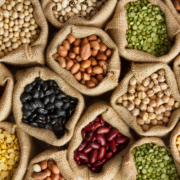Edit the Balance of Your Plate
 If I mention “balancing your plate” are you picturing a plate spinning on a stick, or just sitting steadily on the tip of your finger? Relax. That’s not what I mean.
If I mention “balancing your plate” are you picturing a plate spinning on a stick, or just sitting steadily on the tip of your finger? Relax. That’s not what I mean.
I’m not talking about balancing the plate itself, but rather the contents of the plate … your food. And I’m referring to balancing the macronutrients that make up your meal.
Macronutrients is a big word that means “a type of food (e.g., fat, protein, carbohydrate) required in large amounts in the human diet.”
Whoa! What jumps out to you as being outside our normal expectations these days? Notice that fat is noted as a food that we require in large amounts? That’s NOT what the media have been advocating for the past several decades.
Why would fat be counted as a macronutrient? Because fats are important for protecting our organs, maintaining cell membranes, promoting growth and development and absorbing essential vitamins. Yet not all fats are created equal.
Fats fall into different categories – saturated, unsaturated and trans fats. I’m sure that you have heard of the issues with trans fats, and I would strongly encourage you to consider them off-limits for your healthy balanced plate. Instead, you can aim to include around 20% of your meal from saturated and unsaturated sources.
Good options to consider for your healthy plate would be wild-caught, cold-water fish, nuts and seeds, extra virgin olive oil, avocado, organic butter, and coconut oil.
Another part of your balanced plate is protein, and we have been as unbalanced in that area as we have with fat. Picture the normal plate at a steakhouse – how much of that plate is covered by your steak?
Would you be surprised to find out that the appropriate protein portion should cover just 1/4 of your plate, and would be about the size of a deck of cards or the palm of your hand? Most people would!
In our culture of ever-growing portions, the Whopper burger and plate-size T-bone are considered the norm, but these are far more protein than our bodies need.
So the first steps you can take to balance your plate for better health is to reduce your protein portion (use a to-go box to take the excess off your plate) and increase your healthy fat content. I’ll talk about the rest of your balanced plate in my next newsletter.
We have been talking about ways to skip the diets and focus on EDITs to improve your health. If you put these tips into action, you will likely be satisfied while actually eating less. That could support weight loss as you pursue wellness for you, for life – because health is wealth.





Leave a Reply
Want to join the discussion?Feel free to contribute!